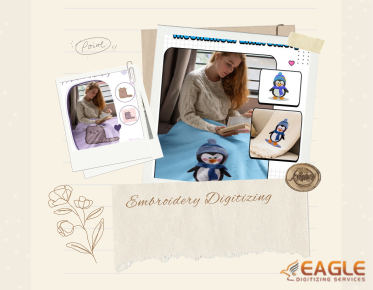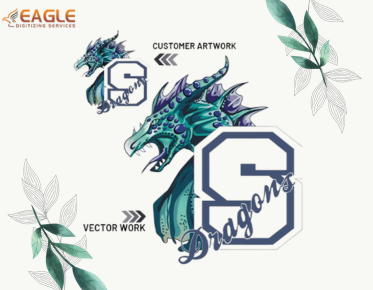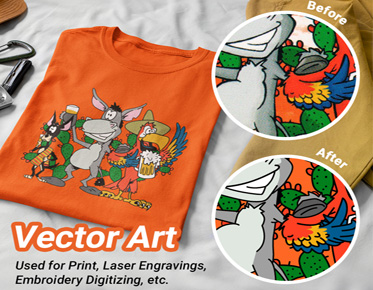Where to Find Inspiration for Your Embroidery Projects Like a Pro
The Art of Finding Inspiration for Your Embroidery
Embroidery is more than just stitching thread through fabric; it’s a
form of self-expression, creativity, and an art that thrives on inspiration.
But where does this inspiration come from? The world around us is brimming with
potential, just waiting to be noticed and transformed into beautiful stitches.
Whether you're a seasoned embroiderer or a newcomer, the key to creating
captivating designs lies in finding fresh sources of inspiration. Let’s dive
into the world of ideas and techniques that will help you tap into your
creative flow and elevate your embroidery projects.
Why
Inspiration is Key to Great Embroidery
Inspiration is the spark that ignites creativity. Without it, even the
most skilled embroiderer can struggle to produce designs that feel personal or
exciting. When you're inspired, you’re energized, and the possibilities seem
endless. Inspiration fuels your creativity, guiding you in making choices about
color, texture, and pattern. It is through inspiration that we find the courage
to explore new techniques and break free from the constraints of routine. The
more diverse and abundant your sources of inspiration, the more you can grow as
an artist.
Breaking
Through Creative Blocks: A Guide for Every Artist
Every artist, no matter their discipline, faces moments of creative
block. But when it comes to embroidery, even the smallest spark of an idea can
open the floodgates of creativity. To break through those blocks, change your
environment, try new techniques, or look to different art forms for fresh
perspectives. Whether it’s taking a walk or scrolling through social media,
finding new stimuli can reawaken your creativity and make the needle feel like
an extension of your thoughts.
Nature’s
Bounty: The Best Place to Start Your Creative Journey
One of the most obvious yet endlessly inspiring sources for embroidery
ideas is nature. From the smallest flower to the vast, endless sky, nature offers
an infinite well of design possibilities. It’s not only about copying what you
see but about capturing its essence, translating textures, colors, and patterns
into thread. Nature’s beauty can awaken a profound connection to your work,
reminding you that art doesn’t have to be forced—it can simply flow from the
world around you.
Flowers, Leaves, and Beyond: How Nature Influences Your Stitches
The flora and fauna around you offer endless inspiration for intricate
stitchwork. Flowers, in particular, are beloved subjects for embroidery due to
their diverse shapes, colors, and textures. From a delicate rose to a simple,
elegant daisy, each petal can be brought to life through stitches. Leaves,
vines, and trees offer sweeping, organic lines perfect for adding movement to
your designs. Look closely at nature’s smallest details—the veins of a leaf or
the curve of a petal—and transform them into stunning stitchwork that captures
the beauty of the natural world.
The
Beauty of Landscapes: Mountains, Oceans, and Sky in Embroidery
Nature’s grand scale is equally inspiring. Imagine the rugged majesty
of mountains, the calm serenity of an ocean horizon, or the vastness of an open
sky. These expansive elements can be captured in embroidery through color
gradients, textures, and shapes. For instance, a mountainous landscape might
inspire a layered, textured stitchwork that mimics the depth of the terrain. An
ocean scene could come to life with smooth, flowing threads representing the
water’s movement. Nature’s vastness is rich with potential, just waiting to be
stitched.
Textures
in Nature: Bringing the Outdoors to Your Thread
Textures
play a crucial role in translating nature into embroidery. From the rough bark
of a tree to the soft petals of a flower, each element can be interpreted
through various stitching techniques. Using raised stitches, knots, and
layering, you can add texture to your embroidery to create a tactile sense of
nature. It’s all about experimenting with different stitch types and colors to
replicate the textures of the outdoors in your work. Nature offers a wide
variety of textures, each with its unique characteristics. By studying the
details closely, you can translate even the simplest leaf veins or rocky
surfaces into intricate stitchwork. It’s not just about mimicking nature—it’s
about capturing the essence of it. Whether through the use of color gradients
or the incorporation of 3D textures, nature’s beauty can shine through every
stitch.
Everyday
Objects: Seeing the Beauty in the Mundane
Inspiration
doesn’t always have to come from grand, sweeping vistas. The everyday objects
we encounter can be a goldmine for creative ideas. By looking at ordinary
things with a fresh perspective, you can find design possibilities in the mundane.
A coffee cup, a bowl of fruit, or a pattern on your favorite sweater—all of
these objects hold subtle details that can become beautiful embroidered
creations. Everyday objects often carry with them personal memories or
experiences that can enhance their meaning in your artwork. Consider the unique
shapes, textures, or colors of items around you, and allow these qualities to
inspire your designs. The simplest items, when examined carefully, reveal an
astonishing world of design potential, perfect for embroidery. What might seem
insignificant at first glance can transform into a stunning piece of art with a
little creative focus.
Everyday
Items You Can Embroider: Turning the Ordinary Into Extraordinary
Everyday
items often have simple, geometric shapes that lend themselves perfectly to
embroidery. You can transform ordinary things like keys, cups, and books into
intricate designs by focusing on their shapes, textures, or patterns.
Embroidering objects from your daily life invites a deeper connection to the
materials and surroundings you engage with each day, allowing your art to
reflect your environment. These familiar items often carry meaning, making your
embroidery personal and unique. Whether it's the curve of a favorite mug or the
texture of a cozy sweater, small details can evoke a sense of nostalgia and
warmth in your creations. By taking the ordinary and turning it into something
extraordinary, you infuse your art with both beauty and personal significance.
Finding
Color Palettes in Your Daily Life
Colors
are everywhere around us, from the hues of your morning coffee to the changing
tones of the sky. Observing and collecting color combinations throughout your
day can become a great source of inspiration. Perhaps the warm, earthy tones of
autumn leave you inspired, or the vibrant pastels of a sunset ignite your
creativity. The beauty of everyday life is often in the small details—the
shades of colors that shift and change, much like the thread on your needle.
These fleeting moments can be captured in embroidery, immortalizing the natural
world’s beauty. The colors of a flower blooming, the deep greens of a forest,
or the soft blues of the ocean can all inspire new color schemes for your work.
By incorporating these colors into your embroidery, you can create pieces that
feel alive and connected to the world around you.
Objects
Around the House: Inspiration Hiding in Plain Sight
Your
home is filled with objects that may seem ordinary but hold immense potential
for embroidery designs. A patterned rug, an old
teacup, or even the texture of a piece of furniture could all inspire unique
projects. Take time to look at everyday items through an artistic lens and see
how they can be reimagined with thread. The mundane is often where the most
striking designs hide. By shifting your perspective, you can find beauty in the
smallest details. Old photographs, fabric scraps, or the contours of household
items can spark ideas that you hadn’t considered before. By turning these
familiar items into art, you bring new life to the objects that surround you
every day.
Looking
to Art and History for Classic Embroidery Ideas
Art
history is an endless resource for embroidery inspiration. Whether it’s the
geometric patterns of ancient civilizations or the romanticized florals of
18th-century tapestries, classic art can spark fresh ideas. Artists throughout
history have used embroidery in various forms to express themselves, and by
studying their work, you can find new techniques and motifs to incorporate into
your designs. The wealth of inspiration found in classical art also allows you
to explore diverse themes and styles, whether it’s the simplicity of early
Renaissance art or the opulence of Baroque designs. As you study the details of
these works, you can discover stitching techniques that have stood the test of
time, blending the old with the new in your embroidery. By looking back at art
history, you connect with a lineage of creativity and expression that continues
to influence modern artists.
Old
School Cool: How Vintage Art and Patterns Spark New Ideas
Vintage
art often carries with it a sense of timelessness. Oldembroidery patterns, antique textiles, and historical designs can all
inspire new creations. Whether you’re drawn to the florals of Art Nouveau or
the symmetrical patterns of Art Deco, vintage art offers a range of styles that
can enrich your work. Embroidering these historical motifs gives you a chance
to connect with past art movements while adding your personal touch. Vintage
patterns often feature intricate detailing, offering a rich source of
inspiration for those looking to add depth and complexity to their designs. By
reinterpreting these classic elements with modern techniques and colors, you
breathe new life into timeless pieces. Vintage art invites you to combine the
past and present in your work, creating something that feels both nostalgic and
contemporary.
Medieval,
Baroque, and Beyond: How History Can Shape Your Stitches
Medieval tapestries, Baroque embroidery, and Renaissance art provide an intricate level of design and detail that can be directly applied to modern embroidery projects. The use of rich colors, ornate patterns, and elaborate textures can guide your stitching techniques and help you create truly stunning pieces. History’s legacy in textile art can shape how you think about color, stitchwork, and design. From the bold, dramatic designs of the Baroque period to the flowing elegance of medieval tapestries, each era has its distinct style that can influence your work. These historical textiles often feature storytelling elements, offering an opportunity to weave narrative into your embroidery. By drawing inspiration from these classic periods, you can create pieces that not only showcase technical skill but also reflect the artistry and cultural context of the time.
Inspired by Famous Artists: A Fresh Take on Iconic Designs
Famous artists like Van Gogh, Picasso, and Klimt have created works that have inspired countless generations. Their iconic designs can be reimagined through the art of embroidery. Think of recreating the swirls of Van Gogh’s “Starry Night” with thread or adding texture to Picasso’s bold figures. These reinterpretations give you the freedom to experiment and adapt timeless works to your style. By translating these famous artworks into embroidery, you can challenge your skills while paying homage to these masters of art. Each stitch becomes a personal interaction with their creations, allowing you to reinterpret and add your voice to their iconic pieces. Whether you choose to stay true to their style or put a unique spin on it, using famous art as inspiration opens the door to endless creative possibilities.



